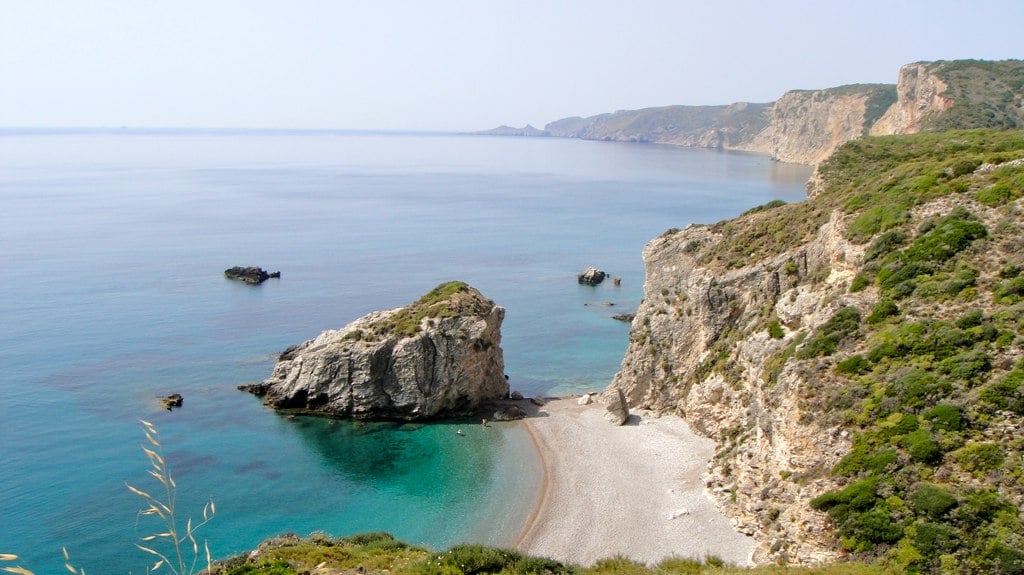
The natural sea salt that comes from the Greek island of Kythera, once considered an exclusive delicacy, is now gaining renewed attention for its nutritional value.
The harvesting process for this salt is notably demanding, requiring both endurance and patience. This traditional method involves pumping seawater into the natural rock cavities, allowing it to evaporate over several weeks.
The process of harvesting the salt includes various stages based on old local traditions. Nestled in the rocky shores of the region, natural cavities house the precious salt. During the winter, the fierce waves fill these hollows with seawater, which gradually evaporates from mid-July to September. Fishermen and salt collectors patiently and cautiously gather the salt in wicker baskets, allowing it to bask in the sun, a practice that has endured for centuries.
Το «#αλάτι_των_βράχων», οι #αλυκάριοι των #Κυθήρων και η ιστορία ενός 14χρονου που ξενιτεύτηκε με δύο κιλά αλάτι στη βαλίτσα τουhttps://t.co/kPKTRY0fbr pic.twitter.com/XhiFHOfyUH
— Πρακτορείο Μακεδονία (@praktoreiomaced) May 27, 2021
Every year, about thirty regions in Kythera with natural salt troughs are put up for auction. Interested individuals lease these areas for salt harvesting from the Domestic Property of Kythera and Antikythera, an institution established during the Anglo-occupation.
Kythera Salt’s Health Benefits and Conditions of Storage
This ancient process of harvesting results in the renowned rock sea salt of Kythera. It is distinguished by its rich array of beneficial elements and minerals, including higher levels of potassium and magnesium, and a lower sodium chloride concentration, making it less harmful for those with hypertension. The subtle infusion of sea flora, such as algae and moss, adds a unique and delightful flavor to this exceptional product.
To maintain its quality, it is recommended that the salt be stored in jars with a lid, preferably non-metal, or in specific salt containers. This will shield it from moisture and sunlight, ensuring its quality is maintained.
The Island of Kythera, Cultural and Historical Site
The island of Kythera, located across from the southeastern tip of the Peloponnese, boasts stunning beaches and lush mountainous landscapes.
From picture-perfect Kythera Island we wish you a lovely weekend💙 #AllYouWantIsGreece #VisitGreece #Kythera #GreekIslands #staysafe #Greece pic.twitter.com/gQHC4fjp2i
— Visit Greece (@VisitGreecegr) June 18, 2021
The island, although less renowned than its neighbor Antikythera, hosts the remarkable Antikythera Mechanism discovered near its shores. With its ancient origins, Kythera also houses the oldest sanctuary devoted to the goddess Aphrodite.

Throughout the 19th century, it served as a cultural crossroads for Greek, Venetian, and Ottoman influences, significantly shaping its identity. Under Venetian rule, Kytherians excelled in arts, politics, and commerce, embodying a rich and diverse cultural heritage.
The island has produced notable politicians, academics, and artists, including General Panos Koroneos, MP Panagiotis Tsitsilias, and poet Lafcadio Hearn.
Kythera is also renown for its majestic castles. For instance, Kythera’s Chora castle, originally from the late Byzantine Period, housed the Venetian Governor and now hosts the Kythera Historical Archives.
Kato Chora Mylopotamou Castle offers well-preserved houses and stunning Byzantine churches, featuring the emblem of the Republic of Venice.
See all the latest news from Greece and the world at Greekreporter.com. Contact our newsroom to report an update or send your story, photos and videos. Follow GR on Google News and subscribe here to our daily email!



